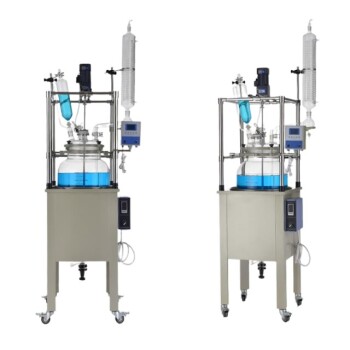A rotary evaporator, commonly referred to as a "rotavap," is a sophisticated piece of laboratory equipment designed for the efficient and gentle removal of solvents from samples through evaporation. The key components of a rotary evaporator include the evaporation flask, vacuum pump, condenser, collection flask, and a heating bath. These components work in unison to facilitate the distillation process under reduced pressure, which lowers the boiling point of the solvent, allowing for more efficient and safer evaporation. The rotating flask increases the surface area for evaporation, while the condenser cools and condenses the vapor back into liquid form, which is then collected in the receiving flask. The vacuum pump plays a crucial role in reducing the pressure within the system, and the heating bath provides the necessary thermal energy to the solvent.
Key Points Explained:

-
Evaporation Flask (Rotating Flask):
- Function: Holds the sample and solvent mixture. The flask is typically made of borosilicate glass to withstand thermal stress and chemical corrosion.
- Design: Often a round-bottom or eggplant-shaped flask to maximize the surface area for evaporation.
- Operation: The flask rotates to enhance the evaporation process by increasing the surface area exposed to the vacuum and heat.
-
Vacuum Pump:
- Function: Reduces the pressure inside the system, which lowers the boiling point of the solvent, allowing it to evaporate at lower temperatures.
- Importance: Essential for preventing thermal degradation of heat-sensitive compounds and for efficient solvent removal.
-
Condenser:
- Function: Cools the solvent vapors, converting them back into liquid form.
- Types: Can be a coil condenser or a cold finger condenser. The coil condenser circulates coolant through a coil, while the cold finger condenser uses a chilled surface to condense vapors.
- Efficiency: The condenser's efficiency is critical for the recovery of solvents and the overall effectiveness of the distillation process.
-
Collection Flask:
- Function: Collects the condensed solvent after it passes through the condenser.
- Design: Typically a round-bottom flask, positioned below the condenser to receive the liquid distillate.
- Capacity: The size of the collection flask should be appropriate for the volume of solvent being distilled.
-
Heating Bath:
- Function: Provides controlled heating to the evaporation flask, facilitating the evaporation of the solvent.
- Types: Can be a water bath or an oil bath, depending on the required temperature range.
- Control: Temperature control is crucial to ensure that the solvent evaporates at the desired rate without overheating the sample.
-
Rotating Mechanism:
- Function: Rotates the evaporation flask to increase the surface area for evaporation and to ensure even heating.
- Design: Includes a motor unit and a mechanical seal to ensure smooth and leak-proof rotation.
- Speed Control: Adjustable rotation speed allows for optimization of the evaporation process based on the sample's properties.
-
Vacuum System:
- Function: Maintains the reduced pressure within the system, essential for lowering the boiling point of the solvent.
- Components: Includes a vacuum pump, vacuum gauge, and sometimes a vacuum controller for precise pressure regulation.
- Safety: Proper sealing and pressure monitoring are critical to prevent leaks and ensure safe operation.
-
Additional Components:
- Vapor Duct: Connects the evaporation flask to the condenser, allowing the vapor to travel from the flask to the condenser.
- Liquid Feed System: Introduces the process feed into the system under vacuum, ensuring continuous operation.
- Product Cooler: Cools the condensate before collection, preventing thermal degradation of the collected solvent.
In summary, the rotary evaporator is a complex system with multiple components that work together to achieve efficient and controlled solvent evaporation. Each component plays a vital role in the overall functionality of the rotavap, ensuring that the process is safe, efficient, and effective for a wide range of laboratory applications.
Summary Table:
| Component | Function | Key Features |
|---|---|---|
| Evaporation Flask | Holds the sample and solvent mixture | Round-bottom or eggplant-shaped; rotates to increase surface area for evaporation |
| Vacuum Pump | Reduces pressure, lowering the solvent's boiling point | Prevents thermal degradation; ensures efficient solvent removal |
| Condenser | Cools and condenses solvent vapors into liquid | Coil or cold finger design; critical for solvent recovery |
| Collection Flask | Collects condensed solvent | Round-bottom design; size matches solvent volume |
| Heating Bath | Provides controlled heating to the evaporation flask | Water or oil bath; precise temperature control |
| Rotating Mechanism | Rotates the flask to enhance evaporation | Adjustable speed; ensures even heating |
| Vacuum System | Maintains reduced pressure for efficient evaporation | Includes vacuum pump, gauge, and controller; ensures safe operation |
| Additional Components | Includes vapor duct, liquid feed system, and product cooler | Supports continuous operation and prevents thermal degradation |
Discover how a rotary evaporator can optimize your lab processes—contact us today for expert advice!















